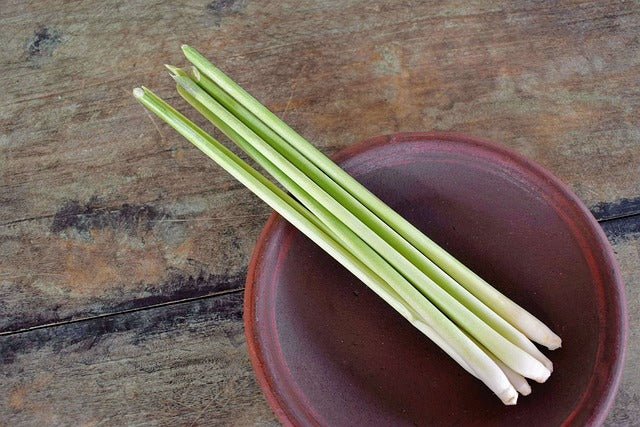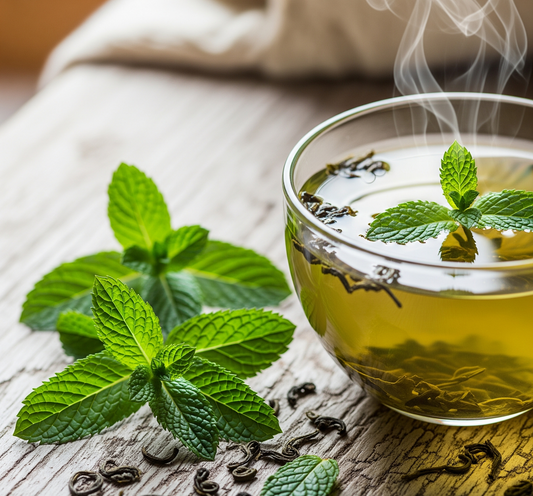Looking for something to spruce up your herb garden? We have an easy to grow, easier to care for, and a delicious kitchen staple for you:
Lemongrass is a fragrant, ornamental grass that is just perfect for your herb garden. For gardeners looking to grow aromatic herbs that can be used for cooking in soups and stirs and even in refreshing herbal teas, lemongrass is a tasty and easy to grow option.
In this blog, we'll explore how you can cultivate this delightful herb in your own garden.
Whether you're an avid gardener, a culinary enthusiast, or a health-conscious individual, lemongrass is sure to captivate your senses and offer a range of benefits.

What is lemongrass?
Lemongrass is a fast-growing tropical herb with a lemony aroma and taste. Native to India and Sri-Lanka, this herb features in many Asian dishes for its zesty flavor and aroma. The vivid green, long and slim leaves turn into a rich, burgundy color in the colder months, which will give your garden a lovely, autumnal look.
How to plant lemongrass?
As lemongrass is native to tropical environments, they require a lot of sunlight, water and humid environments to thrive. It is best to start your lemongrass plants in pots and transfer them to your garden in the springtime, to protect the plant’s young leaves from winter frost.
If you’re looking for a lush, grassy look to your kitchen garden and plan to plant add several lemongrass plants to your planting beds, make sure your plants are spaced at least 24 inches apart to allow each plant to grow. In areas that receive a lot of direct sunlight and water, lemongrass plants will grow rapidly and in thick clumps.
Potted lemongrass plants require a pot that is at least 12 inches wide. To ensure good drainage and a good root network, make sure your pot is deep enough to support your lemongrass plant.
How to propagate lemongrass?
As lemongrass grows in clumps, it is easy to propagate lemongrass plants. Here is how to propagate lemongrass by division:
- Dig up a clump of lemongrass.
- Each clump of lemongrass has leaf fans that are attached to a bulb-like base, with roots attached. Each of the bulbs with roots attached can grow into individual clumps. With a spade, you can divide your clump into pieces containing at least five or six of these bulbs attached.
- Replant the divisions immediately in new pots or in your plant beds.
- Water thoroughly and be sure to water your divisions daily.
You can also germinate your lemongrass seeds and plant them in your plant beds. However, lemongrass seeds are hard to find, as most retailers sell living planters that are to be transferred as they grow.
How to pot and repot lemongrass?
Your lemongrass plants not only need to develop healthy root systems but are also top heavy, with large lumps of grassy leaves growing above soil. To avoid your plant from tipping over, get a wide pot that is at least 12 inches in diameter.
How quickly your lemongrass plant grows and how thick the grass is depends on the quality of your potting soil. Choose a potting soil with premixed fertilizer to keep your plants fed and healthy all year around.
Growing lemongrass in colder climates is far trickier than growing the plant under warm conditions. However, during the winter, you can still grow a single bulb in a small pot on a sunny spot or windowsill. It’s best to repot your plant in the spring, before the warm months for rapid and healthy growth.

Create the perfect environment for your Lemongrass to thrive!
Light
Lemongrass plants grow best under at least six hours of direct sunlight, even in the summer months.
If planted in the shade, the grass will be sparse and low in fragrance, and might even attract mosquitoes and other pests.
Soil
Nutrition-dense, loamy soil is best for growing lemongrass. With compost and manure, even types of manure like tea manure, you can create the ideal soil type for your lemongrass plants that will favor thick, fragrant and flavorful lemongrass.
Avoid planting your lemongrass in clay soil or soil types that typically makes water puddle. Though lemongrass craves humidity and moisture, soil that is not well-drained call kill your lemongrass plant.
Water
It is important not to let the roots of your lemongrass plant dry out. Plant your lemongrass in rich, well-drained soil that is able to hold onto water.
Make sure you are watering your lemongrass plants consistently whenever the top inch of the soil becomes dry.
Fertilizer
As a grassy plant, lemongrass grows best with application of nitrogen-rich fertilizers. A slow-release fertilizer that will enrich the plant throughout its growing season will work best for dense, grassy plants. To add trace nutrients to the soil, you can also water your lemongrass plants with manure tea.
Pest Control and Troubleshooting
Lemongrass plants are used to repel insects due to their citrusy odor. They are usually not bothered by pests unless they are grown with insufficient sunlight and water, or are growing in colder climates.
How to prune your lemongrass plant
If your lemongrass plant is over a season old, it may need a tidy-up. A prune will remove dead foliage and allow for rapid new growth.
During the winter months, lemongrass plants will die pack to protect itself from frost. During this time, it is best to leave the browning leaves unpruned. Once spring arrives, shear your grass to 4-6 inches high. The plant will rebound and start growing new shoots in the summer.
What are some problems with growing lemongrass?
Lemongrass plants dry out very quickly, as the plants crave moisture and humid environments. Outdoor lemongrass plants growing in plant beds are more tolerant of dryness, but potted lemongrass can dry up quickly, especially in the winter. It is best to not let the top couple of inches of your lemongrass plants dry out.
However, lemongrass plants, if watered incorrectly, can suffer from rust fungus. You can tell if your plant is dying from rust fungus if you begin to spot brown spots or brown streaks on the leaves. By watering the plants at soil level and avoiding keeping the lemongrass leaves wet for too long, you can prevent rust fungus.
Lemongrass is a vivid and beautiful grass for your kitchen garden, as well as a fragrant and delicious addition to your kitchen. Easy to grow, lemongrass is also extremely versatile. Whether you add lemongrass garnish to your dishes or make a series of summery mocktails with your lemongrass, let its lemony fragrance uplift your spirits. Happy gardening and bon appétit!
Need organic lemongrass in your pantry right away? We've got you. While your lemongrass grows its pretty and fragrant leaves in your garden, try out our organic lemongrass from Nepal:
Frequently Asked Questions:
How fast does lemongrass grow?
It can grow relatively fast indoors and outdoors (in the right environments), potentially reaching several feet tall in one season.
How do I harvest lemongrass?
It is alright to harvest your lemongrass whenever you need some lemongrass for your kitchen! As lemongrass is a fast-growing plant, harvesting from your plant won’t affect its growth. Snip some lemongrass leaves to steep lemongrass tea or use it in broth.
The stalks of the lemongrass plants should be peeled to reach the softer inner layers, which can be a fragrant addition that adds a lemony note to your dishes.
Is lemongrass easy to grow?
Yes, lemongrass is easy to grow and care for both in indoor pots and outdoor plant beds. However, because lemongrass roots can grow rapidly, you should keep an eye on your pots and repot your plant when necessary.
What is the difference between lemongrass and citronella?
Unlike lemongrass, citronella isn’t edible. It has a similar, though more pungent, citrusy odor which is often used to repel insects.




